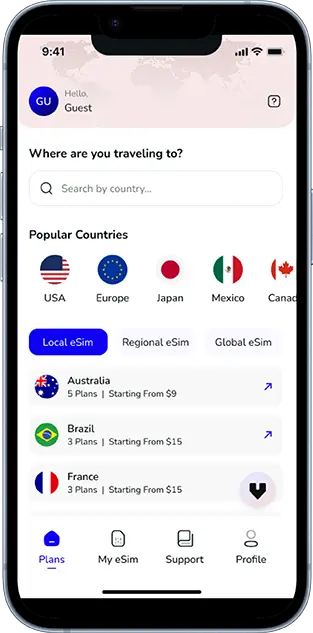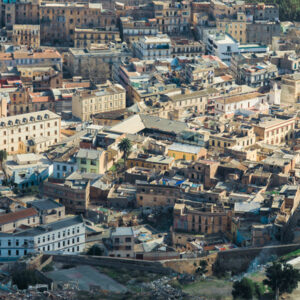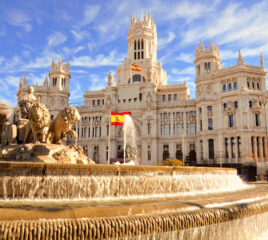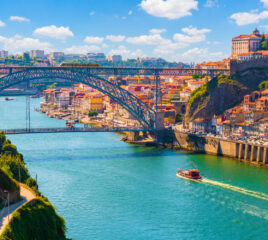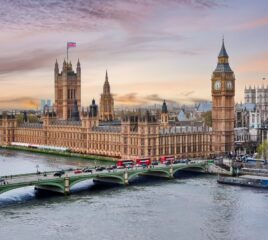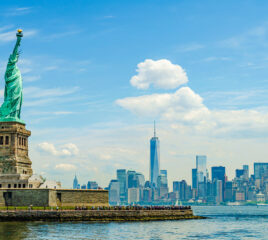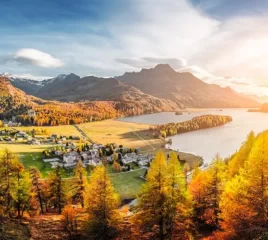Note that iPhone devices from Mainland China aren’t eSIM compatible. Also iPhone devices from Hong Kong and Macao aren’t compatible (except for iPhone 13 Mini, iPhone 12 Mini, iPhone SE 2020 and iPhone XS)
Algeria, the largest country in Africa, stretches from Mediterranean shores to deep Saharan dunes, offering a spectrum of landscapes, cultures, and histories. While Algiers often dominates travel itineraries with its cosmopolitan buzz, there’s an entire world beyond the capital waiting to be explored. From ancient Roman ruins to lively coastal ports and UNESCO-listed desert towns, Algeria’s lesser-known cities provide immersive experiences that reward curious travelers.
These destinations combine rich heritage, distinct architectural styles, local traditions, and vibrant food scenes. They are places where you can sip mint tea in a centuries-old kasbah, watch the sun sink into the Mediterranean, and hear the call to prayer echo off desert walls – all without the crowds you might find in the capital. This guide takes you through five remarkable cities that showcase Algeria’s depth and diversity.
Constantine – The City Suspended Above the Ravines
A City Carved by Nature and History
Perched dramatically on a rocky plateau and sliced by the deep Rhumel Gorge, Constantine is unlike any other city in North Africa. Known as the “City of Bridges,” it has been inhabited for over 2,000 years, from its Numidian origins as Cirta to its flourishing under Roman, Byzantine, Arab, and Ottoman rule. Its strategic position atop cliffs made it a natural fortress, but it is the blend of cultural depth and visual drama that leaves visitors spellbound.
The city’s unique layout forces you to interact with its geography. Every walk between neighbourhoods takes you across bridges that are both engineering marvels and panoramic lookouts. This fusion of natural beauty and human ingenuity is at the heart of Constantine’s identity.
Stay Connected in Algeria
Activate your digital eSIM before exploring Algeria’s diverse regions.
Main Attractions
Sidi M’Cid Bridge
Arguably Constantine’s most famous landmark, this suspension bridge hangs 175 metres above the Rhumel Gorge, offering spectacular views of the city and surrounding cliffs. Walking across it is a thrilling experience, especially at sunset when the sky turns a soft orange.
Sidi Rached Viaduct
An impressive stone viaduct built during the French colonial era, it holds the record as one of the tallest stone bridges in the world. It’s best appreciated from below, where its massive arches frame the gorge.
Cirta Museum
A must for history enthusiasts, the museum houses Roman mosaics, Numidian sculptures, and Islamic artefacts, providing context for Constantine’s ancient roots.
The Kasbah
The city’s historic quarter, with its winding alleys, offers a journey back in time. Traditional houses, small mosques, and bustling markets give a taste of Constantine’s everyday life.
Emir Abdelkader Mosque
One of Algeria’s largest and most beautiful mosques, combining Ottoman and modern design elements. Non-Muslim visitors can admire it from outside, but its grandeur is still impressive from the street.
Hidden Corners
While most visitors stick to the major attractions, Constantine has quieter spots worth seeking out:
- Tea Houses in the Old Quarter: Small, dimly lit cafés serving sweet mint tea in traditional glass cups, where locals gather to talk politics and football.
- Artisan Workshops: Hidden behind unmarked doors, these spaces produce leather goods, copperware, and embroidered fabrics by hand.
Food & Dining
Constantine’s food scene is deeply rooted in Algerian home cooking but elevated with regional specialities.
- Chakhchoukha: Shredded semolina flatbread soaked in lamb stew with vegetables and chickpeas.
- Mtewem: Meatballs cooked with garlic, chickpeas, and a rich tomato sauce.
- Makroud el Louz: Almond paste pastries dusted with sugar, served during festive occasions.
For authentic dining, try a family-run restaurant in the Kasbah or the newer establishments on the outskirts for a modern twist on classic dishes.
When to Visit
The best times to visit Constantine are April to June and September to early November, when temperatures are mild and ideal for walking tours. Summers can be hot and dry, while winters are cooler and sometimes rainy, but the city’s charm is year-round.
Travel Tips
- Dress Code: Modest clothing is appreciated, especially when visiting religious sites.
- Photography: Always ask before photographing people. Some older residents prefer not to be photographed.
- Safety: Constantine is generally safe for tourists, but avoid deserted areas late at night and keep valuables secure.
- Local Phrases: A few words of Arabic or French go a long way – “Shukran” (thank you) and “Bonjour” (hello) will earn smiles.
Constantine offers an unforgettable mix of natural spectacle, ancient history, and living culture. Its dramatic bridges, vibrant markets, and warm hospitality make it a city worth more than just a passing stop – it’s a destination that reveals Algeria’s complexity in every view and conversation.
Explore Algeria Seamlessly
Stay online for maps, bookings, and instant travel assistance.
Béjaïa – The Mediterranean Port of the Kabyle Coast
A Harbour City with Ancient Roots
Béjaïa, set between the Mediterranean Sea and the Kabyle Mountains, is one of Algeria’s most captivating yet often-overlooked destinations. Known in Roman times as Saldae, the city has a history shaped by Phoenician traders, Berber dynasties, and French colonial administrators. Its deep-water harbour made it a vital Mediterranean port for centuries, and its position at the foot of lush hills gives it a striking natural backdrop.
Unlike Algeria’s busier coastal cities, Béjaïa offers a more relaxed pace, where fishing boats share the shoreline with beachgoers and locals stroll along the seafront in the cool evening air. The surrounding mountains and marine reserves make it an excellent base for both cultural sightseeing and outdoor adventures.
Main Attractions
Cap Carbon Lighthouse
Towering 220 metres above the sea on one of the highest coastal cliffs in the Mediterranean, the Cap Carbon Lighthouse offers panoramic views of the coastline. On clear days, you can see far across the bay, and in autumn, migratory birds pass overhead in large numbers.
Yemma Gouraya National Park
Named after a local saint, this park blends rugged mountains with pristine beaches. Hiking trails lead through pine forests to viewpoints overlooking turquoise coves. The area is also home to Barbary macaques, an endangered primate species found only in North Africa.
Béjaïa Casbah
The old fortified quarter holds traces of the city’s medieval past. Wander narrow lanes lined with whitewashed houses, explore small mosques, and enjoy views of the port from the ramparts.
Tichy Beach
About 20 km east of Béjaïa, Tichy is a favourite weekend escape for locals, with soft sand and warm, shallow waters perfect for swimming.
Hidden Gems
While Béjaïa’s major sites are rewarding, the lesser-known spots often leave the strongest impression:
- Kabyle Villages: A short drive inland reveals stone-built villages where life follows the rhythm of agriculture and local craft traditions.
- Secret Coves: Accessible only by foot or boat, these sheltered bays offer peaceful swimming and snorkelling far from tourist crowds.
- Local Olive Groves: Béjaïa is famous for its olives; some small farms allow visitors to tour the groves and sample fresh oil.
Food & Dining
Béjaïa’s cuisine reflects its coastal setting and Kabyle heritage.
- Bouillabaisse Béjaïenne: A local take on the Mediterranean fish stew, rich with spices and fresh herbs.
- Aghroum: Traditional Kabyle bread, often baked in clay ovens and served with olive oil.
- Sea Urchin Platters: A seasonal delicacy in coastal restaurants, especially in spring.
Seafood restaurants along the port serve the freshest catch, but inland eateries offer hearty mountain dishes featuring lamb, lentils, and couscous.
Best Seasons to Visit
Spring (April-June) is ideal, with mild temperatures and blooming wildflowers in the surrounding hills. Early autumn (September-October) offers warm seas for swimming without the peak summer crowds. Winter is mild on the coast but can be rainy, while summer brings more visitors and hotter conditions.
Travel Tips
- Language: While Arabic is widely spoken, many locals also speak Kabyle Berber and French.
- Beach Etiquette: Modest swimwear is recommended outside designated tourist areas.
- Market Shopping: Béjaïa’s markets are great for olive oil, pottery, and woven textiles – bargaining is expected but polite.
- Wildlife Awareness: If hiking in Yemma Gouraya National Park, keep food secure, as Barbary macaques are curious and bold.
Béjaïa offers the perfect balance of seaside leisure, cultural exploration, and mountain adventure. It’s a city where you can hike forested hills in the morning, swim in clear waters by midday, and enjoy a seafood dinner overlooking the harbour at night – all without the crowds of Algeria’s more famous destinations.
If Algeria’s coastal charm inspires you, take a look at Algiers in October: Casbah Walks & Seafront Evenings. It offers a closer view of the capital’s atmospheric neighborhoods, from historic Casbah lanes to relaxed seaside promenades – perfect inspiration before heading into the quieter cities like Tlemcen and Biskra.
Tlemcen – Andalusian Elegance in North Africa
The City of Art, Architecture, and Heritage
Tlemcen, located in northwestern Algeria near the Moroccan border, is a city where every corner whispers a blend of Andalusian refinement and Maghrebi tradition. Once the capital of the Zayyanid Kingdom in the 13th and 14th centuries, it became a centre of art, architecture, and scholarship that rivalled the great cities of the Islamic world. Its rich past is still visible in the harmonious arches of mosques, intricate tilework, and the lush gardens that soften its urban edges.
Surrounded by mountains and blessed with a mild climate, Tlemcen is both a historical treasure and a relaxed escape from busier coastal cities. For travelers seeking a slower pace paired with cultural depth, it’s an essential stop.
Main Attractions
Great Mosque of Tlemcen
Built in 1136, this is one of the finest examples of Almoravid architecture, with elaborate stucco decoration and cedar-wood ceilings. Its prayer hall is a masterpiece of proportion and craftsmanship.
Mansourah Fortress
Just outside the city, these impressive ruins date back to the 14th century and are remnants of a massive fortified complex. The towering minaret still stands as a striking landmark.
Mechouar Palace
Originally constructed in the 13th century, this palace complex reflects Tlemcen’s royal past. Its restored courtyards and gardens give a glimpse of the city’s former grandeur.
Lalla Setti Plateau
A panoramic viewpoint above the city, accessible by cable car, offering sweeping views of Tlemcen and the surrounding mountains.
Hidden Corners
Beyond its famous monuments, Tlemcen rewards curiosity with quieter spots:
- Artisan Weaving Workshops: Producing fine haïks and carpets using traditional looms.
- Historic Fountains and Gardens: Scattered throughout the old city, often unnoticed by hurried visitors.
- Local Hammams: Public baths where centuries-old traditions of relaxation and socialising continue.
Food & Dining
Tlemcen’s cuisine is a marriage of Berber roots, Arab influences, and Andalusian sophistication.
- Rfiss Tlemceni: A semolina and butter dessert flavoured with dates and spices, often served at weddings.
- Berber Couscous Variations: Featuring seasonal vegetables and tender meats, each prepared with its spice blend.
- Tlemcen Pastilla: A savoury-sweet pie of chicken, almonds, and cinnamon wrapped in delicate pastry.
Many of the best dishes are found in family-run restaurants, often tucked into side streets of the old town.
When to Visit
Spring (April-June) and autumn (September-October) are ideal, with mild temperatures and blooming gardens. The city also hosts cultural festivals celebrating Andalusian music and crafts during these seasons.
Travel Tips
- Respect Local Customs: While Tlemcen is welcoming, modest dress is appreciated, especially when visiting religious sites.
- Market Etiquette: Bargaining is expected, but do so with a smile and good humour.
- Photography: Ask permission before taking close-up photos of artisans at work.
- Time Your Visits: Monuments often close during midday prayer times, so plan sightseeing accordingly.
Tlemcen is not just a city of monuments – it’s a living tapestry of history, artistry, and warm hospitality. Here, Andalusian elegance meets Algerian tradition in a setting that invites lingering strolls, unhurried conversations, and a deeper appreciation for the cultural threads that connect North Africa to Europe.
To gain a broader perspective on how Algeria’s cultural rhythm begins in its capital, explore a Solo Trip to Algiers. It offers insight into Algiers’ dynamic character – where modern energy meets historical charm – before venturing into quieter, heritage-rich cities like Tlemcen and Constantine.
No SIM Card Hassles
Enjoy borderless data connectivity with just a quick activation.
Biskra – The Gateway to the Sahara
Oasis Life on the Desert’s Edge
Known as the “Queen of the Zibans,” Biskra sits at the point where Algeria’s northern mountains give way to the Sahara’s golden expanse. This oasis city has been a cultural and agricultural hub for centuries, thanks to its abundant date palms and life-giving underground water channels. In the late 19th and early 20th centuries, Biskra became a winter retreat for European travelers and artists, who came for its warm climate and exotic charm.
Today, Biskra offers a distinctive blend of palm-fringed boulevards, traditional markets, and desert excursions. It’s an ideal base for travelers who want to experience both the serenity of an oasis and the stark beauty of the surrounding Sahara.
Main Attractions
Tolga Palm Groves
Just outside the city, Tolga is famous for producing some of the world’s best dates, particularly the prized “Deglet Nour” variety. Walking through the groves at sunrise or sunset is an unforgettable experience.
Chetma Village
An ancient settlement with mud-brick houses, narrow alleys, and a timeless atmosphere. Local guides can share stories about their history and traditions.
Ziban Gardens
Lush green spaces fed by natural springs, offering a shaded retreat from the desert heat.
Nearby Sand Dunes
Only a short drive from the city, the rolling dunes provide a taste of the Sahara without requiring days of travel.
Hidden Gems
- Thermal Springs: Biskra and its surroundings have several natural hot springs, some with public bathing facilities.
- Local Date Markets: Small stalls piled high with fresh and dried dates, often accompanied by tastings.
- Desert Farms: Family-run plots where you can learn about date cultivation and irrigation systems.
Food & Dining
Biskra’s cuisine reflects its oasis setting and Saharan influences.
- Tagine with Dates and Almonds: A sweet and savoury dish that pairs perfectly with fresh flatbread.
- Chekhchoukha Biskria: Torn flatbread mixed with meat, vegetables, and a rich sauce.
- Makroud el Tmar: Semolina pastries stuffed with date paste, often served with tea.
Many restaurants in Biskra serve traditional meals alongside grilled meats and fresh salads. For an authentic experience, try dining in a local home-stay or small family-run eatery.
Best Seasons to Visit
The best time to visit Biskra is from November to March, when daytime temperatures are pleasant and evenings are cool. Summers can be extremely hot, often exceeding 40°C, making outdoor exploration difficult during the middle of the day.
Staying Connected While Traveling
Moving from Algeria’s coastal cities into remote desert regions can challenge mobile connectivity, especially if you’re navigating without local contacts. Choosing an eSIM for Algeria from Voye Global allows you to stay connected instantly upon arrival, with multi-network coverage that works both in urban centres and many rural areas. It’s particularly useful in a place like Biskra, where you may switch between city streets, palm groves, and desert tracks in a single day – all while needing maps, translation tools, or instant booking confirmations at your fingertips.
Travel Tips
- Heat Precautions: Carry water, wear a hat, and avoid midday outdoor activities in summer.
- Market Etiquette: Bargaining is part of the buying process, but should remain friendly.
- Photography: Always ask before photographing people, especially in traditional villages.
- Desert Trips: Hire experienced local guides for excursions to avoid getting lost or stranded.
Biskra is more than just an entry point to the Sahara – it’s a living oasis where date palms sway over centuries-old irrigation canals, and the rhythm of life slows to match the desert’s pace. For travelers willing to step away from Algeria’s coastal belt, it offers a unique perspective on the country’s diversity.
For travelers planning to explore more of the country’s cultural and geographic variety, the Algeria Travel Guide provides valuable insights on routes, customs, and travel essentials – from coastal cities to deep desert oases.
Travel Smart and Confident
Navigate Algeria’s cities safely using reliable eSIM coverage.
Timimoun – The Red Oasis of the Sahara
A Desert Town Like No Other
Timimoun is one of Algeria’s most visually striking oases, instantly recognisable by the deep red hue of its mud-brick architecture. Located in the heart of the Gourara region, this desert town is surrounded by palm groves, salt lakes, and vast dunes that glow golden at sunrise and crimson at sunset. Its distinctive colour comes from the local clay used in construction, giving the town a warm, cohesive aesthetic that blends seamlessly with the surrounding desert.
Historically, Timimoun sat along caravan routes connecting sub-Saharan Africa with North Africa’s Mediterranean coast. Tuareg, Arab, and Berber influences all meet here, shaping the town’s architecture, crafts, and traditions. For travelers, Timimoun offers a mix of sensory experiences – the smell of spices in the market, the call to prayer echoing off clay walls, and the endless horizon of the Sahara beyond.
Main Attractions
Timimoun Market
The bustling central market is the social and commercial heart of the oasis. You’ll find Tuareg jewellery, woven carpets, spices, dates, and baskets, all sold in a friendly, unhurried atmosphere.
Sebkha Lake
This salt lake lies just beyond the palm groves and offers surreal scenery, particularly at sunrise and sunset when the light plays across the water and surrounding sands.
Ksar Architecture
The old fortified quarters, or ksour, showcase traditional Saharan architecture. Narrow alleys wind between mud-brick walls, and carved wooden doors add decorative detail.
Surrounding Dunes
The Erg Chech and Erg Iguidi dunes near Timimoun are vast, remote, and ideal for overnight camel treks or 4×4 excursions.
Hidden Gems
- Old Irrigation Systems: Ancient foggara channels still carry water from underground aquifers to palm groves. Some can be visited with a local guide.
- Desert Villages: Small settlements around Timimoun preserve traditions unchanged for centuries.
- Handicraft Workshops: Local artisans produce pottery and leather goods using time-honoured techniques.
Food & Dining
Timimoun’s cuisine is shaped by oasis agriculture and desert life.
- Taguella Bread: A traditional flatbread baked in the sand and served with meat stew.
- Lamb and Date Tagine: Combining tender meat with the natural sweetness of dates.
- Mint Tea: Served in small glasses, often with a generous layer of foam, and accompanied by local pastries.
Many guesthouses serve home-cooked meals featuring seasonal ingredients and recipes passed down through generations.
Best Seasons to Visit
The most comfortable time to visit Timimoun is between October and March, when daytime temperatures are warm but not scorching, and nights are cool and pleasant. April and May bring rising heat, while summer months can be extreme, with daytime temperatures exceeding 45°C.
Travel Tips
- Guided Excursions: Always travel with a knowledgeable local guide when heading into the desert.
- Photography: Ask before photographing people, especially in markets or villages.
- Clothing: Light, breathable fabrics for daytime and a warm layer for cool desert nights.
- Hydration: Carry sufficient water on all excursions – the dry heat can be deceptive.
Timimoun is more than just a photogenic stop in the Sahara – it’s a living community where ancient architecture, oasis agriculture, and desert traditions remain intact. Its red walls and golden sands make for a photographer’s dream, but its greatest rewards are the moments of stillness under an endless desert sky.
Conclusion

Exploring Algeria’s lesser-known cities reveals a side of the country few travelers ever experience. From Constantine’s breathtaking bridges to Béjaïa’s Mediterranean serenity, from Tlemcen’s Andalusian elegance to Biskra’s oasis calm and Timimoun’s red-sand horizons, each destination offers its own rhythm, flavor, and story. Traveling through these places means more than sightseeing – it’s an invitation to connect with Algeria’s diverse history, warm people, and natural splendor at your own pace.
And with Voye Global eSIM for Algeria, you can explore confidently while staying connected across coastlines, mountains, and deserts. Whether you’re navigating narrow kasbah streets, sharing photos from the dunes, or booking your next city stay, Voye Global ensures smooth connectivity without the hassle of physical SIM cards. Embrace the freedom of discovery – because in Algeria, every hidden city has a new story waiting to unfold.
FAQs
1. How does Voye Global’s eSIM work for travelers in Algeria?
Voye Global’s eSIM lets you connect to Algerian networks without a physical SIM card. You can activate it before or after arrival, switch between supported networks, and enjoy data access in both urban centres and many rural areas.
2. What is the best time to visit Béjaïa and Sétif?
Spring (April-June) and early autumn (September-October) are ideal for both cities, offering mild weather, blooming landscapes, and lively markets.
3. Can I use Voye Global while traveling between desert and coastal cities?
Yes – Voye Global’s eSIM works across multiple Algerian networks, ensuring smooth coverage whether you’re in coastal Béjaïa or remote Timimoun.
4. What are the must-try dishes in Biskra?
Don’t miss tagine with dates and almonds, chekhchoukha biskria, and makroud el tmar – semolina pastries filled with dates.
5. Does Voye Global offer coverage for remote desert towns like Timimoun?
In most cases, yes. The eSIM connects to available partner networks in remote areas, though speeds may vary based on location.
6. Is it safe to travel solo in Tamanrasset?
Generally, yes – but due to its remoteness, travel with local guides for excursions outside the city. Respect local customs and plan logistics.
7. Can I activate my Voye Global eSIM before arriving in Algeria?
Absolutely – you can install and activate it before departure, so it’s ready the moment you land.
8. How can I reach the Djemila ruins from Sétif?
Djemila is about 50 km from Sétif. You can take a taxi, join a guided tour, or hire a private driver for a half-day trip.
9. Can I use my Voye Global plan for multiple Algerian cities in one trip?
Yes – one Voye Global eSIM plan covers your entire stay, no matter how many cities you visit.
10. Which Algerian oasis offers the most authentic local market experience?
Timimoun’s market is a standout for its Tuareg crafts, spices, dates, and friendly vendors in a relaxed, traditional setting.

Seamless Mobile Data Everywhere
